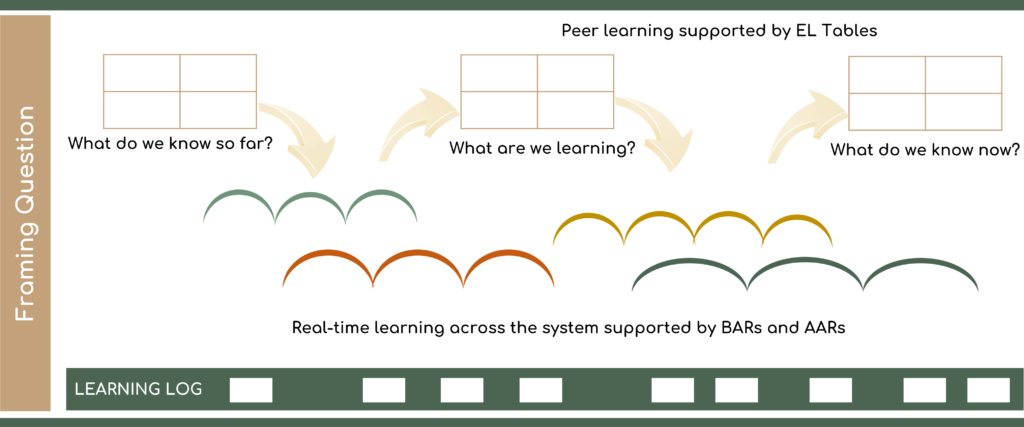A learning practice has its greatest impact when it is done iteratively, over time, focusing on the questions that matter the most to a group.
What does it mean to Steward Learning through Time?
A learning culture gets started when learning becomes a habit, rather than an activity. And that happens when it makes a visible difference in the results we aim to achieve. That means that learning needs to have a thread to it. Learning needs to link back to our strategies and plans, so that we actually notice the difference it makes. That requires stewardship.
Stewardship means holding the ultimate intention of a group’s learning and helping them build it into their regular way of working. It means closing the loop to make sure we notice and reflect on our results. Stewardship does not mean doing the learning for a group. This stewardship can be taken on no matter what formal role a person plays in the group. Who takes on this stewardship role might vary in different teams, organizations, or communities. To start, it might be as simple as noticing the key opportunities in the work to learn something about a question that matters and encouraging a group to do a series of BARs and AARs to turn one-off activities into opportunities to test and refine thinking. Or it might involve helping the group document its intention to focus on learning through a learning agenda and helping them implement it.
What does this principle look like in practice?
The presence or lack of stewarding learning through time can manifest itself in a number of ways. Here is what we have observed:
- If it’s present: Groups become more conscious of the questions they most want or need to learn around. It becomes natural to ask, “what are we learning here?” Because learning is iterative, a group can see its skills around a particular question or its impact around a particular goal accelerating. They develop a shared sense of competence and confidence around what might have previously felt like a recurring barrier. Learning becomes “just how we do our work here.”
- If it’s missing: When learning is not threaded into the way a group works, the group is likely to default to “business as usual” which can also mean “results as usual.” If groups “do learning,” that might mean engaging in one-off learning activities that seem unrelated and do not add up to greater understanding or capability. Because the cost outweighs the benefit, a group’s willingness to “do learning” may erode over time. Without a learning focus, groups tend to lose their line of sight over time and wait until there is a big failure to adjust course.
How Emergent Learning practices support this principle

The practices of Emergent Learning help to steward learning through time:
- Framing Questions make visible where a group wants to focus its learning and invites them to engage in creative thinking and experimentation. Framing Questions can help a group be aspirational about what learning can help them accomplish.
- Emergent Learning Tables help establish a starting point — what do we know so far? Later, they help a group capture and reflect on what they have learned.
- Before and After Action Reviews turn one-off activities into opportunities to experiment, learn and adjust over the course of a project, relationship, or initiative.
- A Learning Log helps individuals in a group to capture their own experiences and insights asynchronously, supports more focused group learning conversations, and captures the history of a group’s results and learning over time.
- A Learning Agenda codifies a group’s learning focus and aspiration and the path they plan take to learn how to achieve it.
One of the thinkers we frequently draw on is John Holland, a pioneer in the study of complex adaptive systems. He spent his career studying the difference between systems that can adapt and those that cannot. He observed that making learning explicit — meaning expressing and testing hypotheses over time — vs. keeping them tacit is one of the most significant factors in the rate at which systems adapt. He describes the difference as “orders of magnitude.” Stewarding learning through time helps us connect the dots and see how our thinking and results are evolving over time. And that helps learning become a habit.
